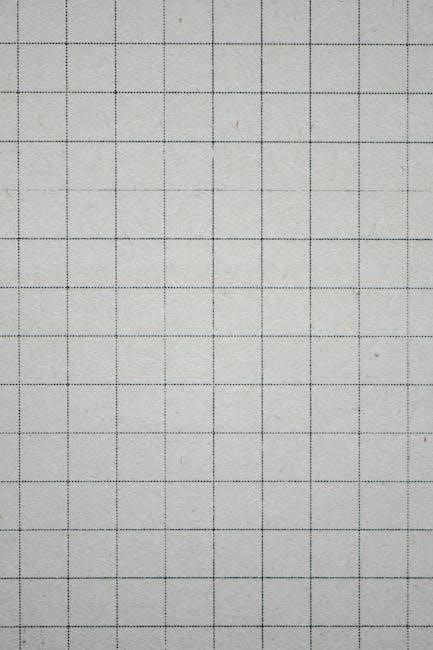
What is Geometry?
Geometry is a fundamental branch of mathematics that studies the properties, sizes, and positions of shapes and figures. It involves the analysis of points, lines, planes, and solids, exploring their relationships and measurements. Derived from the Greek words “geo” (earth) and “metron” (measurement), geometry is essentially the science of measuring and understanding spatial arrangements. It encompasses various elements such as angles, triangles, circles, and polygons, providing tools to describe and solve real-world problems. From basic concepts like collinearity and coplanarity to advanced theories, geometry forms the backbone of mathematical reasoning and practical applications in fields like art, architecture, and engineering. Its logical structure and visual nature make it a cornerstone of problem-solving and critical thinking.

Importance of Geometry in Mathematics
Geometry holds a central position in mathematics, serving as the foundation for understanding spatial relationships and structural patterns. It provides the language and tools necessary for describing and analyzing shapes, quantities, and positions. Geometry’s principles are essential for advancing other mathematical disciplines, such as algebra, calculus, and topology. Its logical reasoning and problem-solving methods enhance critical thinking skills. Beyond mathematics, geometry is vital in science, engineering, and art, offering practical solutions for designing structures, modeling phenomena, and creating aesthetic designs. The study of geometry fosters a deeper appreciation for the order and symmetry present in the natural and built worlds. By mastering geometric concepts, students gain a robust framework for tackling complex problems across various fields, making it an indispensable part of a well-rounded education.
Brief History of Geometry
Geometry’s origins trace back to ancient civilizations, where it emerged as a practical tool for measuring land, constructing buildings, and understanding spatial relationships. The word “geometry” itself comes from the Greek terms “ge” (Earth) and “metron” (measure). Early contributions came from Egyptian and Babylonian mathematicians, who developed methods for calculating areas and volumes. Greek mathematicians, particularly Euclid, laid the foundation with his seminal work “Elements,” which systematized geometric principles into axioms and theorems. Over centuries, geometry evolved, incorporating advancements from Islamic scholars and European mathematicians like Gauss and Riemann, who pioneered non-Euclidean geometries. This historical progression transformed geometry from a practical art into a rigorous scientific discipline, shaping its role in mathematics, physics, and engineering.
Basic Concepts in Geometry
Basic Concepts in Geometry involve points, lines, planes, angles, and their properties. These elements form the foundation for understanding spatial relationships and geometric structures.
Points, Lines, and Planes
Points, lines, and planes are fundamental concepts in geometry. A point represents a specific location in space, having no dimension. A line extends infinitely in both directions, defined by at least two points. A plane is a flat, two-dimensional surface that extends infinitely, defined by at least three non-collinear points. These elements form the building blocks of geometric analysis. Points, lines, and planes can intersect or be parallel, establishing spatial relationships. Understanding these basics is essential for exploring more complex geometric principles and theorems.
Angles and Their Measurement
An angle is formed by two rays sharing a common endpoint called the vertex. Angles are measured in degrees, with a full circle equal to 360 degrees. Acute angles are less than 90 degrees, right angles are exactly 90 degrees, obtuse angles range from 90 to 180 degrees, and straight angles are 180 degrees. Tools like protractors are used to measure angles accurately. Understanding angle relationships, such as supplementary (summing to 180 degrees) and complementary (summing to 90 degrees) angles, is crucial for solving geometric problems. Grasping these concepts lays the foundation for exploring more complex topics like triangle properties and polygon angle sums.
Properties of Points, Lines, and Planes
Points, lines, and planes are fundamental concepts in geometry. A point is a location in space with no dimension, represented by coordinates. Lines extend infinitely in both directions and are defined by at least two distinct points. Planes are flat surfaces extending infinitely, defined by at least three non-collinear points. Key properties include collinearity, where points lie on the same line, and coplanarity, where points lie on the same plane. Lines and planes intersect at points or lines. Axioms such as “two points define a line” and “three non-collinear points define a plane” form the basis of geometric reasoning. Understanding these properties is essential for analyzing shapes, solving problems, and applying geometric principles in real-world scenarios.

Foundations of Geometry
Foundations of Geometry involve axioms, postulates, theorems, and proofs, establishing the logical structure of geometric principles. Euclid’s axioms are central, providing the basis for modern geometric reasoning and problem-solving techniques.
Axioms and Postulates in Geometry
Axioms and postulates are fundamental truths in geometry, serving as the foundation for logical reasoning and theorem development. Euclid’s axioms, such as “things equal to the same thing are equal to each other,” are universally accepted and form the basis of geometric principles. Postulates, like the Parallel Postulate, are specific assumptions that guide geometric constructions. Together, they establish a coherent system for understanding spatial relationships, enabling the derivation of theorems and properties. These axioms and postulates are crucial in both Euclidean and non-Euclidean geometries, providing the necessary framework for advanced geometric analysis and problem-solving.
Theorems and Proofs in Geometry
Theorems and proofs are the cornerstone of geometry, establishing truths through logical reasoning and evidence. A theorem is a statement proven to be true based on axioms, postulates, and previously established theorems. Proofs involve a logical sequence of steps, demonstrating the validity of a geometric principle. For example, Thales’ theorem states that a triangle inscribed in a semicircle is a right triangle, with its proof relying on the properties of circles and angles. These theorems and proofs form the backbone of geometric analysis, allowing mathematicians to explore complex concepts systematically. The process of constructing proofs enhances problem-solving skills and deepens understanding of spatial relationships. By mastering theorems and proofs, learners gain the tools to tackle advanced geometric challenges and appreciate the elegance of mathematical reasoning.

Euclid’s Axioms and Their Significance
Euclid’s axioms are foundational principles in geometry, serving as the building blocks for logical reasoning and theorem development. Introduced in Euclid’s “Elements,” these axioms were designed to be self-evident truths, forming the basis of Euclidean geometry. Key axioms include “Things which are equal to the same thing are also equal to one another” and “If equals are added to equals, the wholes are equal.” These principles were revolutionary, as they allowed geometry to be structured systematically, enabling the derivation of complex theorems through logical proofs. Euclid’s axioms laid the groundwork for modern mathematics, emphasizing the importance of rigor and logical consistency. Their influence extends beyond geometry, shaping philosophical and scientific thought by establishing a standard for rational inquiry and intellectual discourse.

Types of Geometry
Geometry is classified into Absolute, Euclidean, and Non-Euclidean types, each exploring spatial relationships with distinct axioms, such as Euclid’s parallel postulate, shaping their unique theoretical frameworks.
Absolute Geometry
Absolute Geometry, also known as Neutral Geometry, is a branch of geometry that develops without assuming the parallel postulate. It focuses on theorems valid in both Euclidean and Non-Euclidean geometries. This system, rooted in basic axioms, explores properties of points, lines, and planes, emphasizing incidence and order. Key concepts include collinearity (points lying on the same line) and coplanarity (points lying in the same plane). Absolute Geometry’s foundational axioms, such as “two points define a unique line” and “any line contains at least two points,” form the basis for more complex geometric structures. By avoiding the parallel postulate, it provides a universal framework for understanding spatial relationships, making it a foundational study in geometric theory and its applications.
Euclidean Geometry
Non-Euclidean Geometry

Advanced Topics in Geometry
Geometric Transformations
Triangle Properties and Theorems
Circle Theorems and Their Applications

Applications of Geometry
Geometry is vital in problem-solving across art, engineering, and physics, providing tools for design and structural analysis. Resources like Rusczyk’s and NCERT solutions offer insights into its practical applications in real-world contexts.
Geometry in Art and Architecture
and NCERT solutions highlight these applications, offering insights into how geometric theories translate into real-world masterpieces. These tools not only educate but also inspire creativity, bridging the gap between mathematical theory and artistic expression.
Geometry in Physics and Engineering
and NCERT solutions highlight these applications, offering insights into how geometric theories translate into practical solutions. These tools not only educate but also inspire innovation, bridging the gap between theoretical mathematics and real-world problem-solving.
Real-World Problems Solved by Geometry
highlight these applications, demonstrating how geometric knowledge can be applied to real-world scenarios effectively.

Learning Resources and Tools
Recommended PDFs and Online Resources
by Oliver Knill cover advanced topics, including tensor analysis and differential geometry. Online platforms such as Art of Problem Solving and LitRes offer downloadable PDFs and interactive tools. These resources cater to various learning styles, from basic concepts to advanced applications, ensuring comprehensive understanding and practical skill development. They are widely recommended for students, educators, and enthusiasts seeking to master geometry.
Geometry Problem Solving Strategies
Mastering geometry requires effective problem-solving strategies. Start by visualizing the problem and identifying key elements like points, lines, and angles. Use foundational axioms and theorems, such as Euclid’s postulates, to build logical steps. Breaking complex shapes into simpler components, like triangles or rectangles, can simplify analysis. Apply transformations, such as rotations or reflections, to explore symmetries and congruencies. Practice reverse engineering by assuming the solution and working backward. Additionally, leveraging auxiliary lines or constructions can reveal hidden relationships. Regularly reviewing proofs and examples helps reinforce concepts. Utilize online resources, such as problem sets from NCERT or Art of Problem Solving, to refine skills. Consistent practice and critical thinking are essential for excelling in geometry. These strategies empower learners to approach problems systematically and confidently.



